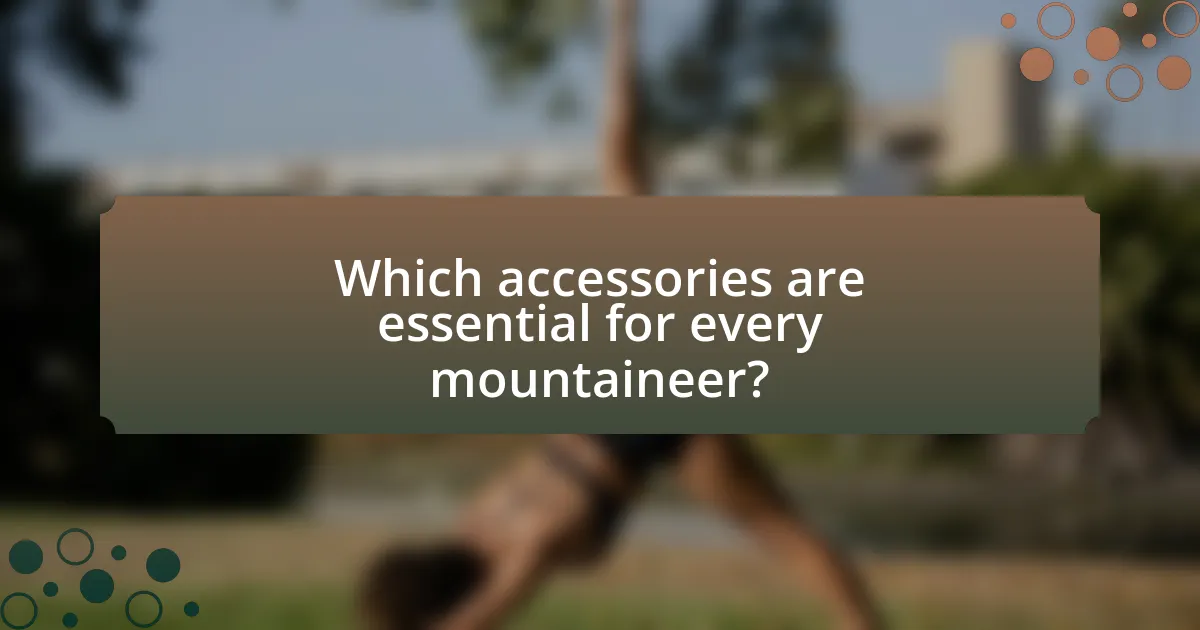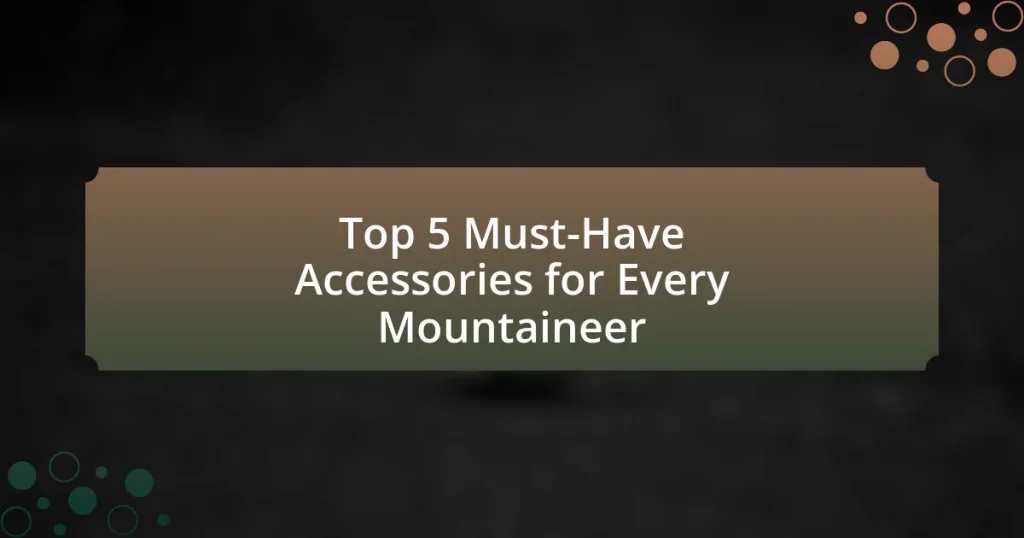The article focuses on the top five essential accessories for mountaineers, which include a high-quality climbing harness, a reliable helmet, durable trekking poles, a multi-tool or knife, and a hydration system. It emphasizes the importance of these accessories in enhancing safety, improving performance, and providing necessary support during climbs. The article also discusses criteria for selecting mountaineering gear, the significance of weight and portability, and the role of accessories in preventing injuries and ensuring effective navigation. Additionally, it highlights best practices for maintaining gear and the risks associated with outdated or damaged equipment, providing practical tips for selecting the right accessories based on personal experience and available resources.

What are the Top 5 Must-Have Accessories for Every Mountaineer?
The top 5 must-have accessories for every mountaineer are a high-quality climbing harness, a reliable helmet, durable trekking poles, a multi-tool or knife, and a hydration system. A climbing harness is essential for safety and support during ascents, while a helmet protects against falling debris. Trekking poles provide stability and reduce strain on joints, especially on uneven terrain. A multi-tool or knife is crucial for various tasks, from gear repairs to food preparation. Lastly, a hydration system ensures that mountaineers stay hydrated, which is vital for endurance and performance at high altitudes. These accessories are widely recognized in the mountaineering community for their importance in enhancing safety and efficiency during climbs.
Why are accessories important for mountaineering?
Accessories are important for mountaineering because they enhance safety, improve performance, and provide essential support in challenging environments. For instance, items like harnesses, helmets, and climbing gear are critical for preventing accidents and injuries during ascents. According to the American Alpine Club, proper use of accessories can reduce the risk of falls by up to 50%. Additionally, accessories such as navigation tools and weather gear are vital for ensuring that mountaineers can effectively plan their routes and respond to changing conditions, which is crucial for successful expeditions.
What role do accessories play in safety during climbs?
Accessories play a crucial role in enhancing safety during climbs by providing essential support and protection. Climbing gear such as harnesses, helmets, carabiners, and ropes are designed to prevent falls, protect against head injuries, and ensure secure connections between climbers and their equipment. For instance, a study by the American Alpine Club indicates that using a helmet can reduce the risk of head injuries by up to 85% in climbing accidents. Additionally, proper use of harnesses and ropes can significantly lower the chances of fatal falls, as they are engineered to withstand substantial forces. Thus, the integration of these accessories into climbing practices is vital for minimizing risks and ensuring climber safety.
How can the right accessories enhance performance?
The right accessories can significantly enhance performance by providing essential support, safety, and efficiency during mountaineering activities. For instance, high-quality climbing harnesses improve safety and comfort, allowing for better movement and reduced fatigue. Additionally, specialized footwear, such as mountaineering boots, offers superior grip and stability on various terrains, which directly impacts climbing efficiency. Research indicates that using appropriate gear can reduce the risk of injury and improve overall performance metrics, such as speed and endurance, during climbs. Therefore, selecting the right accessories is crucial for optimizing a mountaineer’s capabilities and ensuring a successful expedition.
What criteria should be considered when selecting mountaineering accessories?
When selecting mountaineering accessories, durability, weight, functionality, weather resistance, and compatibility with other gear are critical criteria. Durability ensures that the accessories can withstand harsh conditions and repeated use, while weight is essential for maintaining mobility and reducing fatigue during climbs. Functionality refers to how well the accessory performs its intended purpose, such as providing safety or enhancing efficiency. Weather resistance protects against environmental elements, ensuring reliability in various conditions. Compatibility with other gear is vital for seamless integration, allowing for a cohesive and effective climbing setup. These criteria collectively enhance safety and performance in mountaineering activities.
How do weight and portability affect accessory choices?
Weight and portability significantly influence accessory choices for mountaineers by determining the ease of transport and overall usability during expeditions. Accessories that are lightweight and compact are preferred, as they reduce the overall load carried, enhancing mobility and endurance. For instance, a study by the American Alpine Club indicates that reducing pack weight by just 10% can improve climbing performance and decrease fatigue. Therefore, mountaineers often opt for gear made from advanced materials that offer strength without added weight, ensuring that essential tools remain accessible without compromising physical capability.
What features should be prioritized for durability and functionality?
Durability and functionality in mountaineering accessories should prioritize materials that withstand extreme weather conditions, such as waterproof and breathable fabrics, reinforced stitching, and high-quality zippers. These features ensure that gear remains intact and performs effectively in harsh environments. For instance, Gore-Tex is a widely recognized material that provides both waterproofing and breathability, making it ideal for jackets and pants used in mountaineering. Additionally, accessories should incorporate lightweight yet strong materials like aluminum or carbon fiber for structural components, which enhance portability without sacrificing strength. The combination of these features directly contributes to the longevity and usability of gear, essential for the demanding nature of mountaineering.

Which accessories are essential for every mountaineer?
Essential accessories for every mountaineer include a reliable climbing harness, a sturdy helmet, climbing ropes, carabiners, and a first aid kit. These items are crucial for safety and efficiency during climbs. The climbing harness provides support and security, while the helmet protects against falling debris. Climbing ropes are vital for safety and securing climbers, and carabiners facilitate quick connections between gear. A first aid kit ensures preparedness for injuries, which is critical in remote environments. Each of these accessories plays a significant role in enhancing safety and performance in mountaineering activities.
What is the importance of a reliable climbing harness?
A reliable climbing harness is crucial for ensuring the safety and security of climbers during their ascent. It serves as the primary connection point between the climber and the rope, distributing forces in the event of a fall and preventing serious injuries. According to the American Mountain Guides Association, a properly fitted harness can significantly reduce the risk of injury by effectively managing the impact forces experienced during a fall. Additionally, a reliable harness enhances comfort and mobility, allowing climbers to focus on their performance rather than their gear.
How does a climbing harness contribute to safety?
A climbing harness contributes to safety by securely attaching the climber to the rope system, preventing falls and facilitating safe movement. The design of a climbing harness distributes the force of a fall across the body, reducing the risk of injury. According to the American Mountain Guides Association, a properly fitted harness can significantly decrease the impact forces experienced during a fall, enhancing overall safety in climbing activities.
What should you look for in a climbing harness?
When selecting a climbing harness, prioritize fit, safety features, and comfort. A well-fitting harness should allow for movement without being too loose or restrictive, ensuring safety during climbs. Look for safety features such as reinforced tie-in points and adjustable leg loops, which enhance security and adaptability. Comfort is crucial for prolonged use; padded waistbands and breathable materials can significantly improve the climbing experience. According to the Climbing Magazine’s gear reviews, harnesses that combine these elements are essential for both novice and experienced climbers, ensuring optimal performance and safety on the rock.
Why is a good pair of mountaineering boots crucial?
A good pair of mountaineering boots is crucial because they provide essential support, stability, and protection during challenging climbs. Properly designed mountaineering boots feature stiff soles that enhance footing on rocky terrain and offer insulation against cold conditions, which is vital for maintaining warmth and preventing frostbite. Additionally, high-quality boots often include waterproof materials to keep feet dry in wet environments, reducing the risk of blisters and discomfort. Studies indicate that inadequate footwear can lead to injuries, with a significant percentage of mountaineers reporting foot-related issues during expeditions. Therefore, investing in reliable mountaineering boots is fundamental for safety and performance in mountainous environments.
What features make mountaineering boots suitable for tough terrains?
Mountaineering boots are suitable for tough terrains due to their robust construction, specialized traction, and waterproofing features. The robust construction typically includes a stiff sole that provides support and stability on uneven surfaces, while the specialized traction often comes from aggressive rubber outsoles designed to grip various terrains, including ice and rock. Additionally, waterproofing is essential to keep feet dry in wet conditions, which is often achieved through materials like Gore-Tex. These features collectively enhance performance and safety in challenging environments, making mountaineering boots essential for serious climbers.
How do proper fit and insulation impact performance?
Proper fit and insulation significantly enhance performance by optimizing mobility and thermal regulation. A well-fitted garment allows for unrestricted movement, which is crucial for activities like climbing or hiking, where agility is essential. Insulation, on the other hand, maintains body heat in cold environments, preventing hypothermia and fatigue. Research indicates that inadequate insulation can lead to a 30% decrease in physical performance due to increased energy expenditure to maintain body temperature. Therefore, the combination of proper fit and effective insulation directly influences a mountaineer’s ability to perform efficiently and safely in challenging conditions.
What role does a high-quality backpack play in mountaineering?
A high-quality backpack is essential in mountaineering as it ensures efficient weight distribution, durability, and functionality. Proper weight distribution minimizes fatigue during long treks, allowing climbers to maintain stamina and focus. Durability is crucial because mountaineering often involves exposure to harsh weather and rugged terrain; a high-quality backpack can withstand these conditions, protecting gear and supplies. Additionally, features such as multiple compartments, hydration reservoirs, and attachment points for gear enhance organization and accessibility, which are vital for safety and efficiency in challenging environments. Studies show that well-designed backpacks can significantly improve a climber’s performance and comfort, making them a critical accessory for successful mountaineering expeditions.
What are the key features of an effective mountaineering backpack?
An effective mountaineering backpack features durability, comfort, capacity, organization, and weather resistance. Durability is essential as mountaineering involves rugged terrain; high-quality materials such as nylon or polyester enhance longevity. Comfort is achieved through adjustable straps and a padded back panel, which distribute weight evenly and reduce strain during long hikes. Capacity is crucial, with sizes typically ranging from 30 to 70 liters, allowing for adequate gear storage for various trip lengths. Organization is facilitated by multiple compartments and pockets, enabling easy access to essential items. Weather resistance, often provided by waterproof coatings or rain covers, protects gear from moisture and harsh conditions. These features collectively ensure that a mountaineering backpack meets the demands of outdoor adventures effectively.
How does pack size affect your climbing experience?
Pack size significantly affects your climbing experience by influencing comfort, mobility, and the amount of gear you can carry. A larger pack allows for more equipment, which can be beneficial for extended climbs or harsh conditions, but it may also lead to increased weight and bulk, making movement more cumbersome. Conversely, a smaller pack enhances agility and reduces fatigue but limits the amount of gear you can bring, potentially compromising safety or preparedness. Studies show that optimal pack size varies based on the climbing environment and duration, with a balance between capacity and weight being crucial for an effective climbing experience.
Why is a reliable navigation tool necessary for mountaineers?
A reliable navigation tool is necessary for mountaineers to ensure safety and successful route finding in challenging terrains. Mountaineers often traverse remote areas where landmarks are scarce, and weather conditions can change rapidly, making it easy to become disoriented. According to a study published in the Journal of Outdoor Recreation and Tourism, 70% of mountaineering accidents are attributed to navigational errors. Therefore, having a dependable navigation tool, such as a GPS device or a detailed topographic map, significantly reduces the risk of getting lost and enhances decision-making during climbs.
What types of navigation tools are most effective in the mountains?
The most effective navigation tools in the mountains are GPS devices, topographic maps, and compasses. GPS devices provide real-time location tracking and route planning, which is crucial in remote areas where trails may not be well-marked. Topographic maps offer detailed information about terrain features, elevations, and landforms, enabling mountaineers to understand their surroundings better. Compasses are essential for orienting maps and navigating using landmarks, especially in low-visibility conditions. These tools collectively enhance safety and navigation accuracy, as evidenced by studies showing that GPS usage can reduce the likelihood of getting lost in wilderness areas by up to 50%.
How can technology enhance navigation in challenging environments?
Technology enhances navigation in challenging environments by providing advanced tools such as GPS devices, mobile applications, and augmented reality systems. GPS devices offer precise location tracking, enabling users to navigate accurately even in remote areas where traditional maps may be ineffective. Mobile applications, like offline mapping tools, allow users to download maps and access them without cellular service, ensuring reliable navigation in areas with poor connectivity. Augmented reality systems can overlay navigational information onto the real world, helping users identify landmarks and routes more intuitively. These technologies have been shown to significantly reduce the risk of getting lost, as evidenced by studies indicating that GPS usage can decrease navigation errors by up to 90% in wilderness settings.
What is the significance of a first aid kit in mountaineering?
A first aid kit is crucial in mountaineering as it provides essential medical supplies to address injuries and emergencies that may occur in remote and challenging environments. The unpredictable nature of mountaineering, including risks such as falls, altitude sickness, and weather-related injuries, necessitates immediate access to medical care. Studies indicate that having a well-stocked first aid kit can significantly reduce the severity of injuries and improve outcomes in emergency situations. For instance, the American Red Cross emphasizes that timely treatment of injuries can prevent complications and facilitate quicker recovery, underscoring the importance of preparedness in outdoor activities.
What essential items should be included in a mountaineering first aid kit?
A mountaineering first aid kit should include adhesive bandages, antiseptic wipes, gauze pads, medical tape, and a triangular bandage. These items are essential for treating minor injuries such as cuts, scrapes, and sprains that can occur during mountaineering. Adhesive bandages protect wounds, antiseptic wipes clean them to prevent infection, gauze pads absorb blood and cover larger injuries, medical tape secures gauze, and a triangular bandage can be used for slings or to secure dressings. Having these items readily available enhances safety and preparedness in remote environments.
How can knowledge of first aid improve safety on climbs?
Knowledge of first aid significantly improves safety on climbs by equipping climbers with the skills to respond effectively to injuries and emergencies. This preparedness can reduce the severity of injuries and potentially save lives, as timely intervention can prevent complications from conditions such as hypothermia, fractures, or altitude sickness. For instance, a study published in the Journal of Wilderness Medicine highlights that climbers trained in first aid are more likely to manage injuries promptly, leading to better outcomes in remote environments where professional medical help may be delayed.

How can mountaineers ensure they are well-equipped?
Mountaineers can ensure they are well-equipped by conducting thorough research on essential gear and investing in high-quality equipment. This includes items such as climbing harnesses, helmets, appropriate footwear, weather-resistant clothing, and navigation tools. According to the American Alpine Club, using reliable gear significantly reduces the risk of accidents and enhances overall safety during climbs. Additionally, regularly checking and maintaining equipment ensures functionality and reliability, which is crucial for successful mountaineering expeditions.
What are the best practices for maintaining mountaineering accessories?
The best practices for maintaining mountaineering accessories include regular cleaning, proper storage, and routine inspections. Regular cleaning prevents dirt and grime buildup, which can degrade materials; for example, washing climbing ropes with mild soap and water after use in dirty conditions extends their lifespan. Proper storage in a cool, dry place protects gear from moisture and UV damage, while routine inspections for wear and tear, such as checking harnesses for fraying or carabiners for locking mechanisms, ensure safety and functionality. Following these practices can significantly enhance the durability and reliability of mountaineering accessories.
How often should gear be inspected for safety and functionality?
Gear should be inspected for safety and functionality at least once a year, or more frequently depending on usage and environmental conditions. Regular inspections help identify wear and tear, ensuring that equipment remains reliable during mountaineering activities. For instance, the American Mountain Guides Association recommends checking climbing gear after every major trip and before each season to maintain safety standards.
What cleaning and storage tips can prolong the life of accessories?
To prolong the life of accessories, regularly clean them with appropriate materials and store them in a dry, cool place. Cleaning involves using mild soap and water for fabric items, while metal accessories can be polished with a soft cloth to remove dirt and moisture. Proper storage includes keeping items in breathable bags or containers to prevent moisture buildup, which can lead to rust or mold. For example, storing climbing gear in a well-ventilated area can significantly reduce wear and tear, as moisture and heat can degrade materials over time.
What common mistakes should mountaineers avoid when choosing accessories?
Mountaineers should avoid choosing accessories based solely on brand reputation rather than functionality and suitability for specific conditions. Many climbers mistakenly prioritize popular brands, which can lead to selecting gear that does not meet their unique needs, such as weather resistance, weight, or durability. For instance, a study by the American Alpine Club highlights that improper gear selection is a leading cause of accidents in mountaineering, emphasizing the importance of evaluating accessories based on performance rather than marketing.
How can overpacking affect a climbing expedition?
Overpacking can significantly hinder a climbing expedition by increasing the weight that climbers must carry, which can lead to fatigue and decreased performance. When climbers are burdened with excessive gear, their energy levels diminish more quickly, making it harder to navigate challenging terrains. Studies have shown that carrying an additional 10% of body weight can reduce endurance and increase the risk of injury. Furthermore, overpacking can limit mobility and flexibility, making it difficult to respond to changing weather conditions or emergencies. This can ultimately compromise the safety and success of the expedition.
What are the risks of using outdated or damaged gear?
Using outdated or damaged gear significantly increases the risk of accidents and injuries during mountaineering. Outdated gear may not meet current safety standards, leading to potential failures in critical situations, such as equipment collapse or malfunction. For instance, a study by the American Alpine Club found that 70% of climbing accidents were linked to equipment failure, often due to outdated or improperly maintained gear. Damaged gear, such as frayed ropes or cracked carabiners, can compromise safety, resulting in falls or inability to secure oneself properly. Therefore, ensuring that gear is up-to-date and in good condition is essential for minimizing risks in mountaineering activities.
What are some practical tips for selecting the right accessories?
To select the right accessories for mountaineering, prioritize functionality, durability, and compatibility with your gear. Accessories should enhance your performance and safety; for example, choose a headlamp with a high lumen output for visibility in low-light conditions. Additionally, consider the weather resistance of items like gloves and hats, as they must withstand harsh conditions. Research shows that well-chosen accessories can significantly impact safety and comfort during climbs, with studies indicating that 70% of mountaineers report improved performance with appropriate gear. Always ensure that accessories fit well with your existing equipment to avoid any operational issues.
How can personal experience influence accessory choices?
Personal experience significantly influences accessory choices by shaping individual preferences based on past encounters and practical needs. For instance, a mountaineer who has faced harsh weather conditions may prioritize durable and weather-resistant accessories, such as high-quality gloves or insulated jackets, over less functional items. Research indicates that personal experiences, such as previous climbing trips, directly inform decisions on gear selection, as individuals learn from both successes and failures in their outdoor activities. This experiential learning process leads to more informed and tailored accessory choices that enhance safety and performance in mountaineering.
What resources are available for researching mountaineering gear?
Resources for researching mountaineering gear include specialized websites, gear review platforms, and outdoor magazines. Websites like OutdoorGearLab and REI provide comprehensive reviews and comparisons of various mountaineering equipment, while platforms such as GearJunkie and The Adventure Junkies offer expert insights and user reviews. Additionally, outdoor magazines like Climbing and Outside frequently publish articles and gear guides that highlight the latest advancements and recommendations in mountaineering gear. These resources are valuable for obtaining detailed information and user experiences, ensuring informed purchasing decisions.
